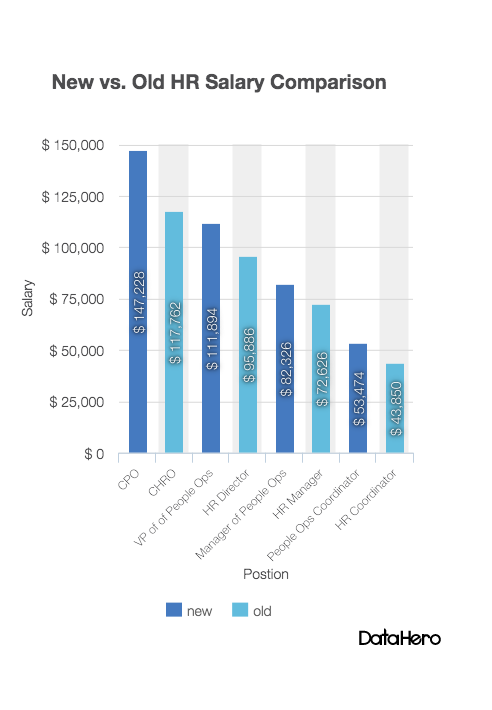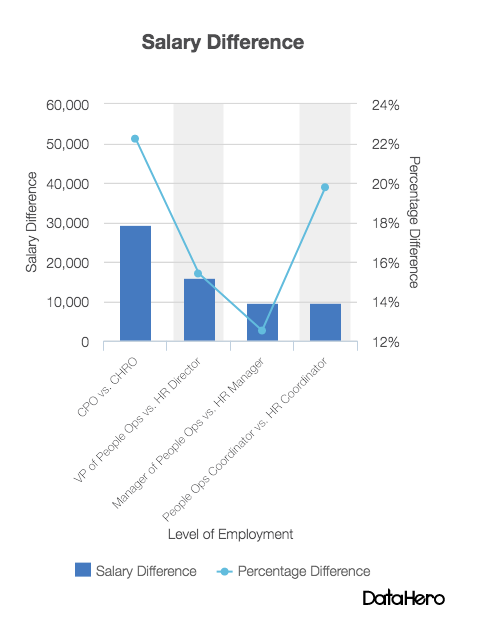HR Jobs Are Changing – and So Are Their Salaries

Due to the increased integration of and reliance on technology, every part of a business is changing, and that includes HR.
Indeed, HR has evolved immensely over the past decade. Technological advancement has spurred a wave of new HR jobs, such as the “chief people officer” and the emergence of “people” teams. Rebranded and refreshed, these jobs do not represent mere title changes, but changes in responsibility, qualifications, and even salary.
We investigated some of the positions in the burgeoning people function and compared them with their old HR counterparts. If it’s true that people vote with their wallets — and companies with their budgets — then the increased salaries of people operations professionals may be indicative of how much more highly valued these new pros are compared to their old HR predecessors.
Here’s what we found:
‘New HR’ vs. ‘Old HR’ Salaries
1. Chief Human Resources Officer (CHRO) vs. Chief People Officer (CPO)
Average CHRO salary: $117,762
Average CPO salary: $147,228
CPOs and CHROs are the top executives of their HR teams. While both positions are high earners compared to other HR pros, the average CPO significantly outearns the average CHRO.
2. HR Director vs. Vice President of People Operations
Average HR director salary: $95,866
Average VP of people operations salary: $111,894
While both are responsible for overseeing their teams, HR directors and VPs of people operations do have some differences between their respective responsibilities. Occupying a more strategic and people-focused position, the VP of people operations is more highly compensated than the HR director.
3. HR Manager vs. Manager of People Operations
Average HR manager salary: $72,626
Average manager of people operations salary: $82,326
Despite the similarity of their titles, the HR manager and the manager of people operations earn quite different salaries, with the newer manager of people operations earning almost $10,000 dollars more per year.
4. HR Coordinator vs. People Operations Coordinator
Average HR coordinator salary: $43,850
Average people operations coordinator salary: $53,474
Typically occupying more administrative, entry-level roles, both HR coordinators and people operations coordinators are among the lower earners of their respective teams. However, the trend does continue here, with the people operations coordinator significantly outearning the HR coordinator.

How Significant Are the Salary Differences?
From the jobs data above, it is easy to see that newer people- operations jobs are earning more than traditional HR roles, but how significant are the differences really? The graph below provides a more concrete visualization of the people -vs.-HR salary gap by tracing both the raw differences in salary and the percentage-wise differences:

In terms of raw salary, the most significant disparity is the $29,466 difference between the top executives’ salaries. The smallest raw salary difference is between the operational positions, which have a gap of $9,624.
In terms of percentages, the greatest difference again exists between executives, with the CPO earning 22.24 percent more on average than the CHRO. The salaries of those in middle management positions have the lowest percentage differences at 12.52 percent. Despite having the smallest raw salary difference, those in operational positions have the second highest percentage difference, with people operations coordinators earning 19.78 percent more on average than HR coordinators.
Overall, the new HR jobs are earning 17.5 percent more than their older counterparts. As we’ve seen in the graphs above, this can translate to many thousands of dollars per year.
Why Such a Wide Salary Gap?
It seems crazy that a title change alone could warrant such varying levels of compensation — but we’re not just talking about title changes. Rather, the key drivers of the salary gap are the new responsibilities and skill sets associated with people operations roles.
As technology has become more fully integrated into all aspects of the organization, business functions have changed radically — especially HR. Previously associated with the enforcement of rules and regulations and administrative duties such as payroll and benefits, HR is becoming in the age of technology a more strategic department. Today’s HR pros rely more on data and analytics to meet employee needs and drive progress toward key business goals.
We can more clearly see the differences between old and new HR when we compare job posts for a CPO and a CHRO. For the CHRO, the main responsibilities include ensuring compliance with company policy, overseeing sourcing and candidate evaluation, and coordinating training and development programs. On the other hand, the CPO’s responsibilities focus on aligning people strategies with business objectives, developing company culture, and driving employee engagement. The CPO job post also calls for candidates who are analytical and business savvy, while the CHRO job post emphasizes project management skills as a key qualification.
For anyone involved in HR, the differences in both responsibility and salary between old and new HR roles warrant sustained attention. Having a better understanding of how HR is evolving could give you a leg up and ultimately help you earn more.
Data for this post was aggregated from LinkedIn and Glassdoor. A version of this article originally appeared on the SelectSoftware blog.
Phil Strazzulla is the founder of SelectSoftware.

